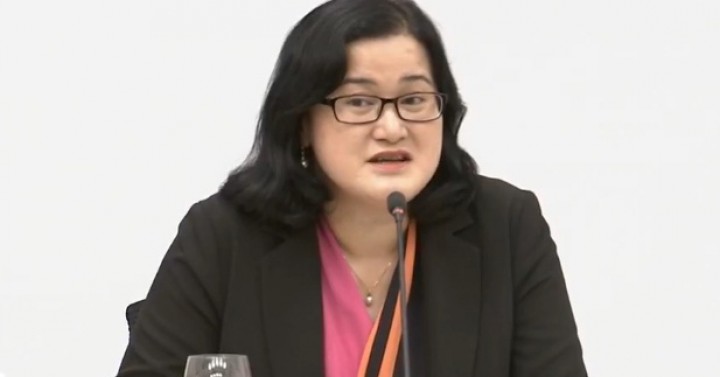Economic managers adjust some economic targets
By Joann Villanueva
Economic managers announced on Thursday, July 18, that they had tweaked some of government’s economic targets such as the inflation assumption for 2019, which was slashed to 2.7-3.5 percent from three to four percent earlier on sustained deceleration of rate of price increases.
In a briefing after the 176th meeting of the inter-agency Development Budget Coordination Committee (DBCC) at the Department of Finance (DOF) office in Manila, Department of Budget and Management (DBM) officer-in-charge Janet Abuel said general price level in the domestic economy has stabilized after peaking at 6.7 percent in 2018.
She attributed the decline in inflation rate partly to Republic Act (RA) 11203, otherwise known as the Rice Tarrification Law, which President Rodrigo R. Duterte signed into law last February 14.
The law lowered domestic rice prices after the government liberalized rice importation.
Authorities said this law has brought down domestic rice prices by about P5 per kilo.
On the other hand, economic managers kept the two to four percent inflation assumption for 2020 to 2022.
Also, they kept the Dubai crude oil assumption for 2019-22 between USD60-75 per barrel.
Meanwhile, the peso-US dollar exchange rate was seen to average between P51-53 this year and P51-55 for 2020 to 2022, better than the P52-55 range set during the DBCC meeting last March.
The adjustment was made on projections of the “possible appreciation of the peso with easing inflation pressures and positive market sentiment with the recent sovereign credit rating upgrade of the Philippines,” Abuel said.
Exports growth target was cut to two percent this year from six percent earlier “due to slower global growth” while the 2020-22 target was maintained at six percent.
Imports is seen to post slower growth of seven percent this year from the nine percent target earlier while the 2020-22 target was maintained at eight percent.
Gross domestic product (GDP) targets were kept at six to seven percent this year, 6.5-7.5 percent for 2020, and seven to eight percent for 2021-22. These are seen to be boosted by the fiscal program.
Government revenue target was kept at P3.15 trillion for this year, which is equivalent to 16.4 percent of GPD while expenditures are targeted to hit P3.77 trillion, 19.6 percent of GDP.
Revenues are targeted to be at P3.54 trillion next year, equivalent to 16.7 percent of GDP; while expenditures were programmed at P4.21 trillion.
By 2021, revenues are seen to rise to P4.42 trillion, 17.2 percent of GDP, and to P5.24 trillion, 20.4 percent of GDP, by 2022.
Abuel said the tax reform program is seen as a reliable revenue source for the government, thus, she stressed the need to complete the passage of the remaining tax reform measures.
“Completing the passage of the remaining tranches of the tax reform will ensure a steady revenue flow and equitable sharing of contributions for the government social and infrastructure programs while securing fiscal stability long into the future,” she said.
With these revenues and spending targets, the budget gap until 2022 was set at 3.2 percent of GDP.
Finance Undersecretary Teresa Habitan, during the same briefing, said that for 2019, the deficit ceiling was set at P624.4 billion; for 2020, P677.6 billion; 2021, P747.6 billion; and 2022, P823.5 billion.
She said the increase in budget deficit target from the three percent target last year is needed because the government needs to increase spending to meet its infrastructure program and boost domestic growth.
Also, National Treasurer Rosalia de Leon, during the same event, said the increase in the budget gap as a percentage of domestic output was made since economic managers “would want to hit our targets in terms of infrastructure spending as a percentage of GDP so it could really bolster in terms of multiplier effect.”
Relatively, Abuel is optimistic of hitting the deficit ceiling amid the underspending in most of the first half of the year on account of the delay in the approval of this year’s national budget.
President Rodrigo R. Duterte signed the P3.7 trillion national budget for this year last April after Congress approved it last February.
Bureau of the Treasury (BTr) data show that as of end-April this year, revenues rose 7.4 percent to P996.4 billion while spending declined by 3.2 percent to P999.8 billion. This resulted to a budget gap of P3.4 billion, 96.8 percent lower than year-ago’s P105.9 billion.
Abuel said the government has adopted a catch-up plan, eyed to be bolstered by the infrastructure spending of the Department of Public Works and Highways (DPWH) and the Department of Transportation (DOTr).
She said DPWH “is on track” but DOTr “needs catching up because of some requirements.”
Most of DOTr’s projects are railways that “require so much studies and paper works.”
“But they also have pending request that were not captured because the evaluation that we did or the reports were as of June 30. So we are expecting them to have bigger or increase the request for funding by July onwards,” she added. (First published by PNA, July 18, 2019)














